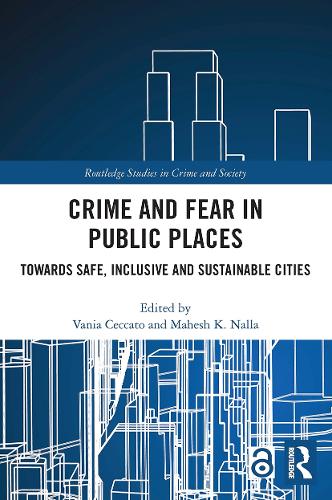Book review: Crime and Fear in Public Places: Towards Safe, Inclusive and Sustainable Cities
reviewed by Lars Marcus
- Created
- 2 Aug 2023, 12:12 p.m.
- Author
Based on: Ceccato Vania and Nalla Mahesh (eds), Crime and Fear in Public Places: Towards Safe, Inclusive and Sustainable Cities, Abingdon: Routledge, 2020; 486 pp.: ISBN: 9780367517694, £39.99 (pbk), ISBN: 9780367371289, £130.00 (hbk)
There is little doubt that the central theme in the many challenges that currently face the cities of the world is crime and fear in public spaces. Whereas many other challenges, such as climate change, weakening social cohesion and economic inequality, often remain rather abstract and are comparably slow processes, the perception of crime and fear is concrete and immediate. Although often related to both weakening social cohesion and economic inequality, it is through the situated experience of fear in public space that for many of us crime and fear become tangible and real.
On a more theoretical level, this is also a longstanding topic for research, at least going back to Jane Jacobs’ early observations of street life. In an academic context, what is studied is not so much the relation between the environment and crime, as that between the environment and fear of crime, whether well-grounded or not. As such, it simply constitutes a very comprehensible example of the fundamental human–environment relation that is central for studies both in environmental psychology and urban planning as well as other fields, albeit from different perspectives.
It can therefore present a long history of study, where the new book from Routledge, Crime and Fear in Public Places: Towards Safe, Inclusive and Sustainable Cities, edited by Vania Ceccato and Mahesh Nalla, is a recent addition. It is an important addition, especially in two senses. First, it broadens the field and, second, it begins to identify theoretical consolidation.
The broadening of the field happens primarily in two ways. On the one hand, this is by introducing studies from a much broader international group of authors, including countries in Africa, Asia and South America that have unfortunately earlier largely been absent since studies have primarily come from Western Europe and North America. This geographic broadening is essential for the field, since crime and fear in public space clearly play out very differently in different parts of the world. There are many dimensions to this, but in simple terms in certain parts of the world crime and fear give rise to deep concern, problematic as they are, and in other parts they fundamentally redistribute behaviour in public space and change the face of the built environment, something made apparent by the broad selection of contributions in this publication.
On the other hand, there is also thematical broadening. There are a range of such themes, of which we choose to only emphasise two. First, several contributions discuss the role of digital space for the field, both methodologically and as part of the phenomenon, which often also changes the nature of crime and fear, creating greater risk for continual harassment, for instance. But not least, it creates new infrastructures for the spread of fear. This in particular is presented by a contribution by Francisco J Castro-Toledo et al. on the emotive responses to terrorist attacks as spread in digital space, primarily by tweets, and how different aspects of these tweets, not least the use of hashtags, condition responses. This seems to be an important methodological contribution not only to this field but also to the study of the impact of social media more generally.
This leads to the other theme we choose to emphasise, which is the idea of victimisation, the risk of being the victim of indecent behaviour, harassment and ultimately violence, not least in a contribution by Mahesh Nalla. There is a particularly spatial quality to this in that it often occurs in spaces where the victim cannot escape, which can be a property of the shape and configuration of public space, but especially in the particular public space constituted by public transport. Whereas other public spaces generally offer the opportunity for alternative routes and escape, these spaces do not, which produces exceptionally vulnerable situations. The character of such spaces not only increases the risk of victimisation but also creates very specific situations that also include bystanders, who choose to either ignore or engage, and at times even to engage on the side of the offender.
Apart from this broadening of the field, the publication also offers promising attempts at its consolidation. In a very useful contribution, Vania Ceccato writes a brief theoretical history of the field both in an attempt to support the diverse contributions to the present volume and as a contribution to theoretical consolidation of the field in general. It touches on the themes highlighted in the volume: the environment, i.e. the actual physical locations of crime and fear; the movement, i.e. the behaviour of people in space; and the interventions, i.e. the different approaches developed to remedy crime and fear in public space – and identifies reoccurring theoretical points of departure in each of them. This is very useful and contributes to a description of the field’s research landscape in a way that may support its future directions but also is a very good introduction for newcomers to the field.
This seems important since, given the significance of the subject matter, the field remains a complex knowledge area that may run the risk of fragmentation and where a more distinct identification of central theoretical approaches may prove essential in guiding the future direction of research. More distinctly defined theoretical strands of research may not least support necessary methodological development. The present volume offers excellent support for this just as it captures the current state of the art of this important field of study.



Comments
You need to be logged in to make a comment. Please Login or Register
There are no comments on this resource.